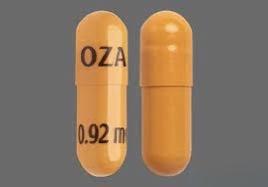Ozanimod and Alcohol/Food Interactions
There are 2 alcohol/food/lifestyle interactions with ozanimod.
Ozanimod Food/Lifestyle
Moderate Food Interaction
GENERALLY AVOID: Foods that contain large amounts of tyramine may precipitate a hypertensive crisis in patients treated with ozanimod. The proposed mechanism involves potentiation of the tyramine pressor effect due to inhibition of monoamine oxidase (MAO) by the major active metabolites of ozanimod, CC112273 and CC1084037. Monoamine oxidase in the gastrointestinal tract and liver, primarily type A (MAO-A), is the enzyme responsible for metabolizing exogenous amines such as tyramine and preventing them from being absorbed intact. Once absorbed, tyramine is metabolized to octopamine, a substance that is believed to displace norepinephrine from storage granules causing a rise in blood pressure. In vitro, CC112273 and CC1084037 inhibited MAO-B (IC50 values of 5.72 nM and 58 nM, respectively) with more than 1000-fold selectivity over MAO-A (IC50 values >10000 nM). Because of this selectivity, as well as the fact that free plasma concentrations of CC112273 and CC1084037 are less than 8% of the in vitro IC50 values for MAO-B inhibition, ozanimod is expected to have a much lower propensity to cause hypertensive crises than nonselective MAO inhibitors. However, rare cases of hypertensive crisis have occurred during clinical trials for the treatment of multiple sclerosis (MS) and ulcerative colitis (UC) and in postmarketing use. In controlled clinical trials, hypertension and blood pressure increases were reported more frequently in patients treated with ozanimod (up to 4.6% in MS patients receiving ozanimod 0.92 mg/day) than in patients treated with interferon beta-1a (MS) or placebo (UC).
Administration of ozanimod with either a high-fat, high-calorie meal (1000 calories; 50% fat) or a low-fat, low-calorie meal (300 calories; 10% fat) had no effects on ozanimod peak plasma concentration (Cmax) and systemic exposure (AUC) compared to administration under fasted conditions.
MANAGEMENT: Dietary restriction is not ordinarily required during ozanimod treatment with respect to most foods and beverages that contain tyramine, which usually include aged, fermented, cured, smoked, or pickled foods (e.g., air-dried and fermented meats or fish, aged cheeses, most soybean products, yeast extracts, red wine, beer, sauerkraut). However, certain foods like some of the aged cheeses (e.g., Boursault, Liederkrantz, Mycella, Stilton) and pickled herring may contain very high amounts of tyramine and could potentially cause a hypertensive reaction in patients taking ozanimod, even at recommended dosages, due to increased sensitivity to tyramine. Patients should be advised to avoid the intake of very high levels of tyramine (e.g., greater than 150 mg) and to promptly seek medical attention if they experience potential signs and symptoms of a hypertensive crisis such as severe headache, visual disturbances, confusion, stupor, seizures, chest pain, unexplained nausea or vomiting, and stroke-like symptoms. Blood pressure should be regularly monitored and managed accordingly. Because of the long elimination half-lives of the major active metabolites, these precautions may need to be observed for up to 3 months following the last ozanimod dose. Ozanimod can be administered with or without food.
References (5)
- (2022) "Product Information. Zeposia (ozanimod)." Celgene Pty Ltd
- (2023) "Product Information. Zeposia (ozanimod)." Bristol-Myers Squibb
- (2023) "Product Information. Zeposia (ozanimod)." Bristol-Myers Squibb Canada Inc
- (2023) "Product Information. Zeposia (ozanimod)." Bristol-Myers Squibb Pharmaceuticals Ltd
- Choi DK, Rubin DT, Puangampai A, Cleveland N (2022) "Hypertensive emergency after initiating ozanimod: a case report." Inflamm Bowel Dis, 28, e114-5
Switch to consumer interaction data
Ozanimod High Blood Pressure (Hypertension)
Moderate Potential Hazard, Moderate plausibility
ozanimod - hypertension
The use of ozanimod may result in increased blood pressure. Care should be exercised when using this drug in hypertensive patients and those at risk for hypertension. It is recommended to monitor blood pressure during treatment and manage it according to clinical practices.
References (1)
- (2020) "Product Information. Zeposia (ozanimod)." Celgene Corporation
Switch to consumer interaction data
Ozanimod drug interactions
There are 940 drug interactions with ozanimod.
Ozanimod disease interactions
There are 10 disease interactions with ozanimod which include:
- CV disease
- CV risks
- hypertension
- infections
- liver dysfunction
- respiratory toxicity
- vaccinations
- encephalopathy
- macular edema
- MS
More about ozanimod
- ozanimod consumer information
- Check interactions
- Compare alternatives
- Reviews (8)
- Side effects
- Dosage information
- Patient tips
- During pregnancy
- Drug class: selective immunosuppressants
- Breastfeeding
- En español
Related treatment guides
Drug Interaction Classification
| Highly clinically significant. Avoid combinations; the risk of the interaction outweighs the benefit. | |
| Moderately clinically significant. Usually avoid combinations; use it only under special circumstances. | |
| Minimally clinically significant. Minimize risk; assess risk and consider an alternative drug, take steps to circumvent the interaction risk and/or institute a monitoring plan. | |
| No interaction information available. |
See also:
Further information
Always consult your healthcare provider to ensure the information displayed on this page applies to your personal circumstances.


